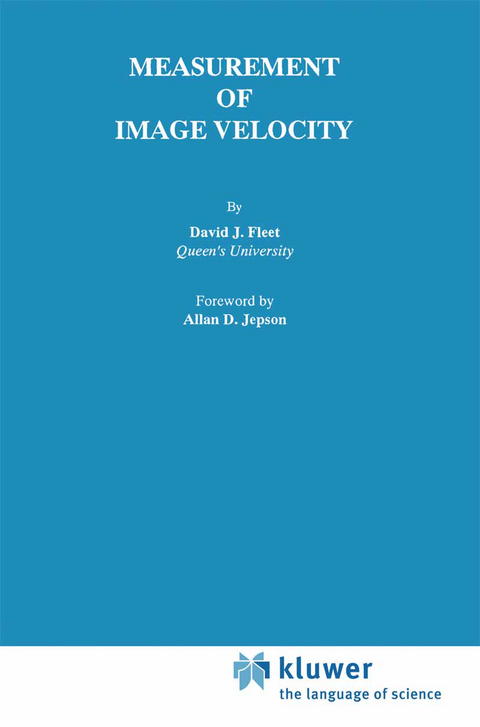
Measurement of Image Velocity
Seiten
2012
|
Softcover reprint of the original 1st ed. 1992
Springer-Verlag New York Inc.
978-1-4613-6623-2 (ISBN)
Springer-Verlag New York Inc.
978-1-4613-6623-2 (ISBN)
Measurement of Image Velocity presents a computational framework for computing motion information from sequences of images. Its specific goal is the measurement of image velocity (or optical flow), the projection of 3-D object motion onto the 2-D image plane.
The formulation of the problem emphasizes the geometric and photometric properties of image formation, and the occurrence of multiple image velocities caused, for example, by specular reflections, shadows, or transparency. The method proposed for measuring image velocity is based on the phase behavior in the output of velocity-tuned filters. Extensive experimental work is used to show that phase can be a reliable source of pure image translation, small geometric deformation, smooth contrast variations, and multiple local velocities. Extensive theorectical analysis is used to explain the robustness of phase with respect to deviations from image translation, and to detect situations in which phase becomes unstable. The results indicate that optical flow may be extracted reliably for computing egomotion and structure from motion.
The monograph also contains a review of other techniques and frequency analysis applied to image sequences, and it discusses the closely related topics of zero-crossing tracking, gradient-based methods, and the measurement of binocular disparity. The work is relevant to those studying machine vision and visual perception.
The formulation of the problem emphasizes the geometric and photometric properties of image formation, and the occurrence of multiple image velocities caused, for example, by specular reflections, shadows, or transparency. The method proposed for measuring image velocity is based on the phase behavior in the output of velocity-tuned filters. Extensive experimental work is used to show that phase can be a reliable source of pure image translation, small geometric deformation, smooth contrast variations, and multiple local velocities. Extensive theorectical analysis is used to explain the robustness of phase with respect to deviations from image translation, and to detect situations in which phase becomes unstable. The results indicate that optical flow may be extracted reliably for computing egomotion and structure from motion.
The monograph also contains a review of other techniques and frequency analysis applied to image sequences, and it discusses the closely related topics of zero-crossing tracking, gradient-based methods, and the measurement of binocular disparity. The work is relevant to those studying machine vision and visual perception.
I Background.- 1 Introduction.- 2 Time-Varying Image Formation.- 3 Image Velocity and Frequency Analysis.- 4 Velocity-Specific Representation.- 5 Review of Existing Techniques.- II Phase-Based Velocity Measurement.- 6 Image Velocity as Local Phase Behaviour.- 7 Experimental Results.- 8 Computing 2-D Velocity.- III On Phase Properties of Band-Pass Signals.- 9 Scale-Space Phase Stability.- 10 Scale-Space Phase Singularities.- 11 Application to Natural Images.- IV Conclusions.- 12 Summary and Discussion.- Appendices.- A Reflectance Model.- B Proof of an n-D Uncertainty Relation.- D Additional Experiments.
| Erscheint lt. Verlag | 30.9.2012 |
|---|---|
| Reihe/Serie | The Springer International Series in Engineering and Computer Science ; 169 |
| Zusatzinfo | XIII, 203 p. |
| Verlagsort | New York, NY |
| Sprache | englisch |
| Maße | 155 x 235 mm |
| Themenwelt | Sachbuch/Ratgeber ► Natur / Technik ► Garten |
| Informatik ► Grafik / Design ► Digitale Bildverarbeitung | |
| Informatik ► Theorie / Studium ► Künstliche Intelligenz / Robotik | |
| Technik ► Elektrotechnik / Energietechnik | |
| ISBN-10 | 1-4613-6623-2 / 1461366232 |
| ISBN-13 | 978-1-4613-6623-2 / 9781461366232 |
| Zustand | Neuware |
| Haben Sie eine Frage zum Produkt? |
Mehr entdecken
aus dem Bereich
aus dem Bereich
Modelle für 3D-Druck und CNC entwerfen
Buch | Softcover (2022)
dpunkt (Verlag)
34,90 €
alles zum Drucken, Scannen, Modellieren
Buch | Softcover (2024)
Markt + Technik Verlag
24,95 €


